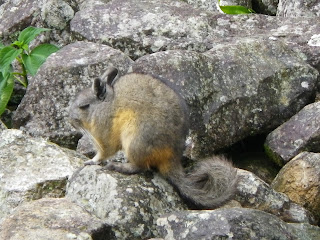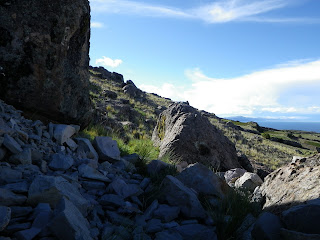Hello folks!
An exclusively verbal update--I've landed in Valdivia, Chile after touring the southernmost stretches of Nothofagus forest and bearing the mighty wind of the Patagonian steppe. I'm now settled for a few weeks at a hostel/permaculture demonstration center, where I'm working on putting together a rocket stove/thermal mass heater system, as well as cataloguing the plant life of the second-growth rainforest on property owned by the hostel owner...pictures to come!
My camera battery has gone dead, and I have yet to find an adapter for the Chilean electric outlets...there's one at the hostel somewhere, that I just need to get my hands on.
much love,
steve
In case you all were wondering
Friday, March 18, 2011
Tuesday, February 22, 2011
Change in plans
 |
| Up into the cloud forest of the western Andean slope! The town of Abancay lies in the valley below the loosely designated nature preserve where these pictures were taken.. |
 |
Something along the lines of a sunflower, acting much like a tree. |
 |
| Podocarpus, a yew-like conifer of the cloud forest |
 |
Lush epiphytic growth made possible by persistently humid conditions |
 |
Spires surrounding Machu Picchu |
 |
Temple of the Moon (in a cave near Machu Picchu) |
 |
Oft-present rufous-collared sparrow |
 |
| Present-day mammalian inhabitants of Machu Picchu |
 |
| Ruins...fairly complete, I thought, aside from the deficit of rooftops |
 |
| Jungle Jen avoids the gringo trail |
 |
| El Choro trail, near the trailhead in La Cumbre, Bolivia. My hammock didn´t quite work the first night here, but I still managed to get in a decent sleep… |
 |
| High elevation cushion plant bog |
 |
| Diminutive alpine flowering plants |
 |
Beautiful Tachinid (or is it Tachniid…someone correct me) fly in the shrub zone below the paramo |
 |
| I will send baked goods to whoever can tell me what genus this plant is in. |
 |
 |
| Polylepis shrub |
 |
| Great sedge! (I promise to devote an entry to monocots later) |
 |
A happy camper, yours truly, basks in the glory of the lower cloud forest |
 |
| Ryne and Jen walk past some of the hugest bracken fern I´d ever encountered |
 |
| Army ants headed to their bivouac |
 |
| Sock-drying time was great for insect-watching in the sunny Yungas forest |
 |
Typical wet season road conditions in Bolivia |
 |
Ryne has a look at the prop-roots of this “walking palm” (Socratea) that has meandered to a light gap atop a leafcutter ant colony |
 |
Short-tailed pygmy-tyrant nest…the bumblebee-sized bird (tied for smallest passerine in S. America) was too small to photograph. |
 |
A common butterfly near Rurrenabaque, Bolivia |
Friday, February 18, 2011
Paracas, continued
At the bus terminal in La Paz, now...we´re going to be in the area until late afternoon, as the bus drivers that drive between here and Oruro are presently on strike...apparently not an uncommon thing to have happen. It´s nice to not be on a bus after about 20 hours of being on one--we came from the swampy-hot lowland jungle all the way to La Paz on the Altiplano, where we drove the last hour or so through snowy mountain rises.
Back to about a month ago, some pictures to fill in the gaps--with its arid southern coastal desert, it was somewhat surprising to encounter such an abundance of life which the ocean brings--here are a few pictures for illustration...
 |
| Peruvian boobies nest in dried-guano bowl-shaped nests high up on coastal bluffs |
 |
| One of at least three lizard species we found near the cliff´s edge; aside from some lichens, there were no forms of photosynthesizing life for miles. |
Wednesday, February 16, 2011
Epiphytes for Primary Production
You know where you are?!
I couldn´t wait to post these photos - I´ll fill in with details between dry, lifeless Atacama desert and mega-diverse lowland/foothill Amazon rainforest in coming posts. These are all from Parque Nacional Madidi in Bolivia, near Rurrenabaque. Enjoy, and have a lovely evening or day!
 |
| You´re in the jungle, baby! This first frog (Osteocephalus sp.? I don´t know) sitting in a Heliconias plant fully met up with my stereotypical preconceptions of what rainforest must be like. |
I couldn´t wait to post these photos - I´ll fill in with details between dry, lifeless Atacama desert and mega-diverse lowland/foothill Amazon rainforest in coming posts. These are all from Parque Nacional Madidi in Bolivia, near Rurrenabaque. Enjoy, and have a lovely evening or day!
 |
| Vines and palms in abundance |
 |
| Long-tailed Potoo, second sighting at Chalalan Eco-lodge in 15 years |
 |
| Beautifully camouflaged crested toad in the fallen and decomposing forest leaves |
 |
| Cup fungi fruiting on wood |
 |
| ¨Monkey Ladder¨ |
 |
| A vine which has apparently converged on the tetrapod limb. On some nodes, the tendrils appeared to grasp onto neighboring vines with all three extensions, or just hold on by pinching between two. |
 |
| Tree frog on the way back to the lodge. |
 |
| Great big snail! There is a mosquito captured in flight, in the background (I wish I could say it was intentionally photographed). |
Subscribe to:
Comments (Atom)
















